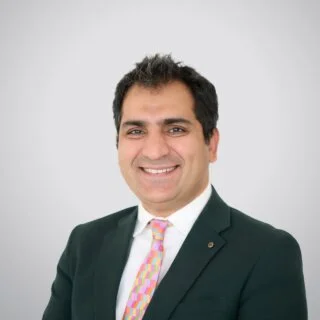Heart valve disease occurs when the valves in the heart do not work properly due to damage or a defect in one of the four heart valves.
How the Heart Valves work
The heart has four valves:
- Tricuspid valve – located between the right atrium and the right ventricle
- Pulmonary valve – located between the right ventricle and the pulmonary artery
- Mitral valve – located between the left atrium and the left ventricle
- Aortic valve – located between the left ventricle and the aorta
The heart valves are located at the exit of the four heart chambers, and they maintain a one-way blood flow through the heart. They make sure that the blood flows in a forward direction without any backward leakage.
Blood flows from the right and left atria into the ventricles through the open mitral and tricuspid valves. When the ventricles get full, the tricuspid and mitral valves shut thus preventing blood from flowing backward into the atria while the ventricles squeeze or contract.
As the ventricles contract, the aortic and pulmonic valves open and the blood is pumped out of the ventricles via the open valves into the pulmonary artery towards the aorta, lungs and the rest of the body.
When the ventricles are done with contracting, they begin to relax and the pulmonic and aortic valves shut instantly, preventing blood from flowing back into the ventricles.
This is a continuous pattern that causes the blood to continuously flow to the heart, lungs and the rest of the body.
Types of Heart Valve Diseases
- Mitral valve prolapse: Also known as click-murmur syndrome, floppy valve syndrome, balloon mitral valve or Barlow’s syndrome, the condition occurs when the mitral valve fails to close properly, causing blood to sometimes flow back to the left atrium.
- Bicuspid aortic valve disease: This occurs when an individual is born with an aortic valve which has two flaps instead of the usual three. In severe cases, the symptoms of this condition are present at birth. However, it is normal for some individuals to go for years without knowing they have this type of disease. This is because the valve can function well for years without any symptoms. Most individuals with bicuspid aortic valve disease are not diagnosed until they are well into adulthood mainly in their 30s or 40s.
- Valvular stenosis: This occurs when the valve fails to open as it should due to stiff or fused leaflets. This means that the blood flowing through the valve is not enough thus leading to heart failure.
- Valvular regurgitation: Also called valvular insufficiency, incompetence or leaky valve, it occurs when any of the heart valve fails to close tightly. This causes the blood to leak backwards and as the leak worsens, the heart works harder to make up for the leaky valve thus pumping less blood to the rest of the body.
Causes of Heart Valve Disease
Heart valve disease can be caused by many factors, with some being present at birth (congenital), while others can be acquired later in life. These include:
- Rheumatic fever
- Heart valve tissue degenerating with age
- High blood pressure and atherosclerosis which may cause damage to the aortic valve
- Heart attack which may cause damage to the muscles that control the heart valves
- Bacterial endocarditis which is an infection of the heart valves (endocardium) and the inner lining of the heart muscle
- Other problems such as rheumatoid arthritis, carcinoid tumours, syphilis or systemic lupus erythematosus
- Radiation therapy
Symptoms of heart valve disease
The symptoms of heart valve problems vary depending on the severity of the problem. Many people with mild to moderate heart valve disease rarely experience symptoms. However, the signs and symptoms include:
- Heart palpitations
- Shortness of breath
- Fatigue
- Dizziness
- Chest pain
- Fainting
- Headache
- A cough
- Pulmonary edema caused by excess fluid in the lungs
- Water retention, which can cause swelling in the abdomen and in the lower extremities
Diagnosis of Heart Valve Disease
During the examination, your physician listens for heart murmurs or distinctive heart sounds, which are most likely to indicate heart valve disease. The doctors may order you to undergo one or more of the following tests:
- Electrocardiogram: Also known as an ECG or EKG, it is used to measure the electrical activity of the heart, thickening of the heart muscle (hypertrophy), regularity of the heartbeats and heart muscle damage from coronary artery disorder.
- Stress testing: Also called treadmill tests, it measures blood pressure, ECG changes, heart rate and breathing during exercise.
- Echocardiogram: This evaluates the heart’s function using waves to create a picture of the heart chambers and valves
- Cardiac catheterization: This test measures pressure irregularities across the valves (to detect stenosis) or observes backflow of an injected dye (to detect incompetence). It involves threading of a catheter into the chambers of the heart.
- Chest X-rays
Treatment of Heart Valve Disease
Treatment for heart valve diseases depends on the severity of the problem and the symptoms presented.
The treatments usually begin with conservative modes of treatment such as:
- Quitting smoking
- Following a healthy diet
- Consistent medical supervision
Medications usually include:
- Diuretics for reducing fluid retention
- Calcium channel blockers and Beta blockers to help in controlling the heart rate and blood flow
- Vasodilators which dilate or open the blood vessels
- Antiarrhythmic medications to control the heart’s rhythm
- Anticoagulants (blood thinners) used for prolonging the blood’s clotting time if the patient is at risk of developing blood clots on the heart valve
Surgery for heart valve disease may be needed if the symptoms are severe. Surgery may include:
- Balloon dilatation to widen a stenotic valve. This technique involves inserting a balloon into a blood vessel using a catheter and then inflating it slightly. Once the size of the opening valve is increased, the balloon is removed.
- Valve surgery to replace or repair a damaged valve. This may involve using artificial valves (prosthetic valves), animal tissue (bioprosthetic valves), your own tissue, mechanical valve or a donated valve from another person. The type of valve replacement used usually depends on the patient’s condition, age and the specific valve affected.
Next Step
At King’s College Hospital Dubai, we focus on offering an exemplary service from initial consultation through to the final diagnosis and treatment and beyond. Our team of expert doctors and nurses are here to offer tailored management and treatment of your condition, and to answer any questions that you might have throughout your time with us. Whatever you need us for, we’re only a phone-call away.
If you’d like to book an appointment, simply fill in the appointment form below.
Faqs
الأسئلة الأكثر شيوعا
Dr. Mehmood (Consultant Interventional Cardiologist), Dr. Omar Hallak (Consultant Interventional Cardiologist), Dr. Jose Carlos Moreno Samos (Consultant Interventional Cardiologist), Dr. Layla Al Marzooqi (Specialist Cardiologist & Aeromedical Examiner) and Dr. Ali K Moussavi (Specialist Cardiologist) are considered the best Cardiologists in Dubai.
BOOK AN APPOINTMENT





